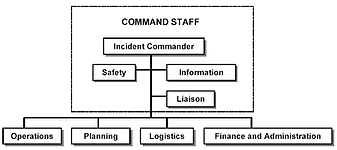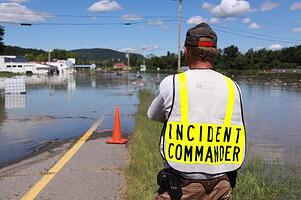Emergency response is an important topic. Although some may never see an incident that requires such structure, prevention is the goal so being proactive is paramount. We here at Safety Training Services, Inc. enjoy educating others on safety topics and for today, our topic is an very important one. We will be covering the importance of the Incident Commander and why you should know what they and an Incident Command System are.
First off, what is an Incident Command System?
Well an Incident Command System, or ICS for short, is a way to standardize the structure of emergency response to allow responders to follow an integrated organizational structure so that any incident can be structured similarly without being hindered by jurisdictional boundaries.
ICS was developed to address the following problems:
- Different organizational structures for emergency response.
- Inadequate communications
- Lack of reliable incident information
- Too many people reporting to one supervisor
- Unclear lines of authority
- A lack of structure for coordinated planning among agencies
- Difference of terminology among agencies
- Unclear or unspecified incident objectives
An ICS divides an emergency response into five manageable functions essential for emergency response operations:
- Command

- Operations
- Planning
- Logistics
- Finance & Administration
What is an Incident Commander?
The incident commander, IC for short, is the overall manager of the emergency response. They directly control the resources and personnel involved in the response. In fact, the IC is responsible for all aspects of the response. This also includes setting priorities and defining organized roles for the response.
Even if other positions are not assigned, the Incident Commander will always be designated.
IC Responsibilities
Unless otherwise specified, the following are some of the complex responsibilities of the Incident Commander.
 Review OSHA's Common Responsibilities (osha.gov)
Review OSHA's Common Responsibilities (osha.gov)- Assess the situation and/or obtain a briefing from prior IC
- Brief the Command Staff and Section Chiefs
- Review meetings and briefings
- Establish immediate priorities especially the safety of responders, other emergency workers, bystanders, and people involved in the incident
- Establish an appropriate organization
- Approve the use of trainees, volunteers, and auxiliary personnel
- Stabilize the incident by ensuring life safety and managing resources efficiently and cost effectively
- Determine incident objectives and strategy to achieve the objectives
- Authorize release of information to the news media
- Ensure planning meetings are scheduled as required
- Establish and monitor incident organization
- Approve the implementation of the written or oral Incident Action Plan (IAP)
- Ensure that adequate safety measures are in place
- Coordinate activity for all Command and General Staff
- Coordinate with key people and officials
- Approve requests for additional resources or for the release of resources
- Keep agency administrator informed of incident status
- Ensure incident Status Summary (ICS Form 209) is completed and forwarded to appropriate higher authority
- Order the demobilization of the incident when appropriate
Personal Protective Equipment (PPE)
 ‘If PPE is to be used to reduce the exposure of ICS/UC workers to hazards, a PPE program should be initialized and maintained. This program should contain identification and evaluation of hazards in the scene and if use of PPE is an appropriate control measure; if PPE is to be used, how it is selected, maintained and its use evaluated; training of workers using the PPE; and vigilance of the program to determine its effectiveness in preventing worker injury or illness. For more on PPE, see OSHA's Personal Protective Equipment (PPE) Safety and Health Topics Page.‘
‘If PPE is to be used to reduce the exposure of ICS/UC workers to hazards, a PPE program should be initialized and maintained. This program should contain identification and evaluation of hazards in the scene and if use of PPE is an appropriate control measure; if PPE is to be used, how it is selected, maintained and its use evaluated; training of workers using the PPE; and vigilance of the program to determine its effectiveness in preventing worker injury or illness. For more on PPE, see OSHA's Personal Protective Equipment (PPE) Safety and Health Topics Page.‘
The FOUR Keys to Successful Implementation
-
Learn
-
Plan
-
Start Early
-
Practice
